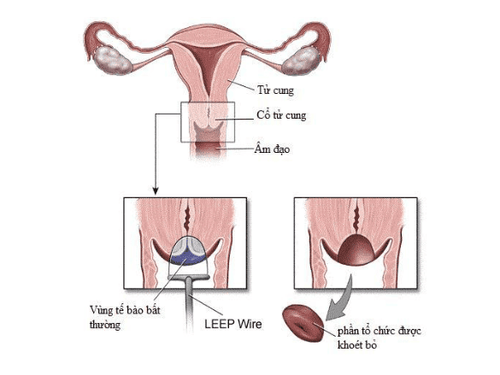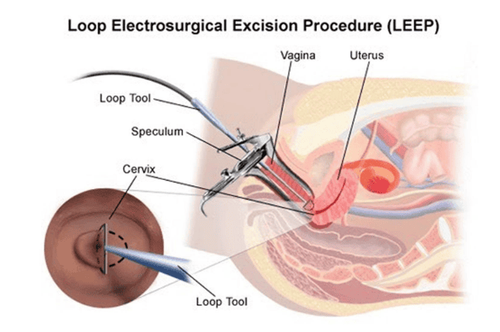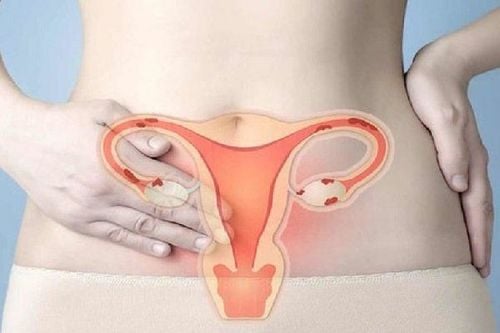This is an automatically translated article.
The article is professionally consulted by a doctor of Obstetrics and Gynecology, Vinmec Danang International General Hospital.Loop electrosurgical excision (LEEP) is a very effective treatment for treating cervical cancer cells. Up to 98% of abnormal cervical cells are removed after a patient has a LEEP.
1. What is a cervical cone?
Cervical conection is the surgical removal of a conical portion of the cervix to remove the lesion in the cervix and the entire transformed area. Cervical conection is indicated for many different reasons, usually to diagnose abnormal changes in the cervix or treat cervical lesions when the results of gynecological investigations such as: Colonoscopy cervical smear, liqui prep or biopsy showing abnormal or suspicious cervical cells.
Cervical conical resection is necessary to:
Follow up with abnormal Pap'smear tests after repeated visits Diagnosing precancerous conditions of the cervix Diagnosing invasive cervical cancer (cancer that has grown into surrounding tissues or has spread beyond the cervix) Treatment of cervical precancerous conditions, carcinoma in situ, or stage IA1 of cervical cancer.
2. Steps to conduct cervical cone incision

Thủ thuật được thực hiện sau khi sạch kinh 01 tuần
Loop Electrosurgical Excision Procedure (LEEP).
2.1.Preparation for cervical cone incision The procedure is performed 1 week after the menstrual period is cleared, avoiding close to menstruation because menstruation affects the cervical cone area. This will make it easier for the doctor to get a clean sample. You should also be sure to discuss any medications you are taking eg hormonal medications... with your doctor. Do not use vaginal suppositories, or douche for at least 24 hours before the procedure. You should also avoid sex during this time. Medicines that can increase the risk of bleeding, such as aspirin, ibuprofen, naproxen, and warfarin, should not be used. Fast for at least 8 hours before the procedure. This procedure usually takes about 1 hour in the hospital. You may be given local anesthesia during the procedure or general anesthesia (sleeping and painless) or a mild pain reliever to help you relax. And you can go home after an average of 2 hours. Re-examination after 01 week, with good results, you have regular check-ups every 6 months. After the procedure, your doctor will prescribe you a prescription for antibiotics and cleaning solutions, along with instructions for home care and follow-up visits. You may experience light bleeding after the surgery, so it's a good idea to bring some pads. Ask a friend or loved one to drive you home after surgery, especially if you are under general anesthesia 2.2. Procedure After going to the toilet. Lie on the gynecological examination table with your legs elevated. The doctor will disinfect the external genitalia and place an instrument (speculum) into the vagina to see the cervix more clearly with the light of the examination light. Using an electrocardiogram (LEEP) to remove a small cone sample from the cervix. With an electric ring, you can stop bleeding at the cut site, or you can use a laser beam to stop bleeding. On average, this procedure only takes a few minutes. The removed tissue sample is sent to a histopathology laboratory to be examined under a microscope for signs of cancer (Diagnostic). This method is also a treatment if the doctor wants to remove all detected diseased tissue.


Thủ thuật khoét chóp cổ tử cung bằng vòng điện (LEEP) điều trị ung thư cổ tử cung
Attention during LEEP:
You feel a sharp pain, then a dull ache or even cramping. There are times when you want to pass out during LEEP. In that case, notify the surgeon immediately. 2.3. What happens after a LEEP is performed? After the cervicectomy, the following signs may appear:
Loose, light pink discharge Mild cramping Dark brown discharge (from scarring on the neck) uterus) For your cervix to heal, it can take up to 4 weeks. As your cervix heals, you shouldn't put anything in your vagina, such as tampons or douches. In addition, you should not have intercourse during the healing period. You can talk to your doctor about when it's safe to have sex again.
Note, you should go to the hospital as soon as you notice any of the following symptoms:
Heavy bleeding (more than your normal period) Bleeding with blood clots Severe abdominal pain. 2.4. Complications After LEEP Bleeding Local Infection In rare cases, the cervix is narrowed after the LEEP procedure. And can cause menstrual disorders (Amenorrhea), affecting a woman's menstrual cycle. In the long-term, when pregnant again, it can cause cervical ectropion, causing preterm birth, early labor.. To minimize the risk of complications, patients need to follow safety measures when monitor and take care of yourself after a LEEP. This also helps the wound in the cervix to heal quickly and limit later effects.

Chảy máu hoặc nhiễm trùng là những biến chứng có thể gặp sau khi làm phẫu thuật LEEP
3. Follow-up examination after cervical cone incision
After the procedure, you will have to see the doctor after 1 week and if normal, you will have a gynecological examination every 6 months. You will have cervical cancer screening tests again to make sure all abnormal cells are completely gone and to make sure they don't come back. If abnormal cervical tissue continues to be detected, the patient is likely to require further aggressive treatment.
Cervical cancer is a very common disease in gynecological diseases. However, now that there is a method of cervical cone dilation by electric ring (LEEP), patients can be completely assured with the advantages of ease of use, low cost, good hemostasis and especially the ability to remove cervical cancer cells are very effective.
Please dial HOTLINE for more information or register for an appointment HERE. Download MyVinmec app to make appointments faster and to manage your bookings easily.
Reference source: Acog.org












